This article concerns CWB divisional tactics. In this context, tactics concern the employment of a few individual brigades and batteries, rather than the use of an entire army over the course of a battle. This article won't tell you how to write the perfect order, defeat Lee or Grant, or give you a fancy operational plan to win at Gettysburg. It will help you get the best out of your troops on any CWB battlefield, and perhaps give you some new tactical ideas.
Why am I writing? Over the past few years I've noticed that I was doing some things right, and they were putting me ahead over the course of a battle. While helping a friend playtest a CWB design last year, he suggested that I try writing some of my tactics and observations down for Operations. He claimed to have learned a few tricks from playing against me and though I could pass them on to other players as well. Since very few articles get down to the level of individual unit handling, I decided to go with his suggestion and write.
[Ed. note: Readers of issue 20 will remember David as one of the writers who has responded to my call for "ROTC" articles dealing with the nuts and bolts of effective play. Any body else out there with good ideas?]
I'll be the first to admit that I'm not the best CWB gamer out there, and what is presented here is just the start of basic CWB tactics, not the final word. If you see something that you think you can do better, or if something seems wrong based on your experience, think about it, write about it, and send it to Operations. Your tactics may work better for or against some styles of play than mine do, and every CWB gamer can benefit from an explicit public discussion of tactics.
This article takes the form of an illustrated quiz. First I present an illustration, then ask a multiple-choice question, with a few possible answers culled from my experience. Finally, I discuss of what I think the correct approach should be. Note that I'm just initiating the discussion. I hope other gamers will continue it, either here in the pages of Operations or over their gaming tables.
The scenario: you command the 1-1 Union division against the H-1 Confederate division. Most percentages or numbers I throw out come from Brandon Einhorn's excellent article "Effective Use of Firepower in the CWB" in Operations 10.
OK, fellow CWB gamers, this is an open-book test. Take as long as you like to finish. You may begin now.
 diagram for question 1:
diagram for question 1:
1. Given two brigades of infantry, and the Rebs coming from the east (right), where do you defend?
-
A) hexes 11.11 and 10.11
B) hexes 11.12 and 10.12
A is a better answer. This is a form of "reverse-slope defense," with the trees acting as the hill. Its advantage stems from the fact that enemy brigades have to enter the woods in order to fire on you. They are forced to endure your range-one shot, which will cause a retreat 19% of the time for B-morale units and 25% of the time for C-morale units. Units which retreat will not be able to on the defending brigades from two hexes away. Additionally, attacking artillery will be unable to fire on the defenders at all.
2. Add an artillery batter to the two defending brigades in question #1. Now where do you defend?
Probably the same positions as before, in the woods. However, you should give serious thought to placing the battery and one of the brigades in hex 11.12. This will allow the artillery to use its longer range to engage approaching attackers. On the other hand, it will negate the reverse slope benefits for these two units and expose the artillery to counterbattery fire, so it is not the first choice. If the attacker is short of artillery, will take a while to close, is using roads in view of hex 11.12, or doesn't employ much counterbattery fire, this option is worth considering.
3. Should you garrison your artillery?
-
A) Duh. Always.
B) Depends. Is the battery in danger if I don't?
The right answer here is B. I've played many opponents who garrison every one of their gun units at all times, and this question is for them. So:
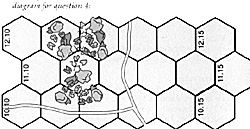 diagram for question 4:
diagram for question 4:
4. you have three brigades and one battery. Where do you defend (again, with the Rebs coming from the east)?
- A) 12.11, 11.10, and 10.11
B) 12.14, 11.13, and 10.14
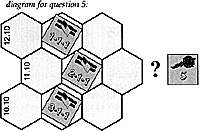 diagram for question 5:
diagram for question 5:
5. Where do you deploy the artillery to best support the defense?
- A) Split it up, with 2 points in 10.11, 2 points in 11.11, and 1 point in 12.11
B) Put the whole 5-point unit in hex 11.11
My experience has been that B is the better answer. Due to the hex grain, hex 11.11 is the most exposed and as a result it should be defended more strongly. Splitting up the battery will spread the benefits of stacked infantry and artillery to all three hexes, but it is vulnerable to counterbattery fire that might strip away the artillery defenses of one or more hexes with only one or two fires. To prevent this, I would keep the whole battery together.
Attacking against someone who does like to split his batteries out, you can often halt for a turn or two and blow away some of his guns before closing. Careful positioning may prevent some of the detached batteries from firing back due to terrain or other LOS interference. More likely, you can arrange for some of your units to be at a longer range from some defending batteries than from others, preventing them from combining fire effectively.
For example, let's say you arrange your attacking artillery so that the 2-point defending battery in hex 11.11 is three hexes away (1 fire point), while the 2-point batter in hex 10.11 is four hexes away (1/2 fire point) and the 1-point battery in hex 12/11 is prevented form firing at all due to terrain or unit positioning. The total is 1 1/2 fire points, and since The Gamers' standard rounding rule does not apply to the CWB series, only 1 fire point can return fire.
If you brought up a full 5-point batter to attack, you fire with 3 fire points, and can probably strip the guns out of hex 11.11 in a turn while taking no casualties at all. Another turn may see the same result for hex 10.11.
 diagram for question 6:
diagram for question 6:
6. Which do you shoot at?
-
A) 5 points on the enemy infantry.
B) 2 points on the infantry, while the guns use their 2 points on the enemy artillery.
My answer is B. Here is why: The infantry has to shoot at the infantry, since it cant target the guns. Why do I want to counterbattery the guns? After all, infantry casualties are worth VPs in most games, and wrecked infantry brigades are more likely to retreat and may even affect corps attack stoppage rolls, whereas gun losses have none of those effects. Simple. I want to knock the opposing battery down to 4 points, which give only 2 fire points at range 2-3, rather than 3. Over the course of several turns, assuming the range stays constant, this will save me casualties. Additionally, the extra stragglers that the infantry brigade will have to take (assuming both fires draw blood) will almost make up for not hitting it with a 5-fire-point attack.
Want the numbers? a 3-point shot at the gun will cause 0.85 casualties, probably knocking it down a point. The same shot will cause (B/C-morale) 0.71/0.92 stragglers from the infantry brigade. Meanwhile, the infantry brigade's 2-point shot causes 0.51 casualties and 0.39/0.51 stragglers. Total against the infantry: 0.51 casualties and 1.21/1.43 stragglers. A 5-point shot would cause 1.17 casualties and 0.96/1.22 stragglers, which compares well but leave the opposing guns at full strength.
What about if the enemy batter had only 4 points? I would probably shoot both infantry and artillery at the infantry brigade in order to wear him down quicker. Knocking the batter from 4 points to 3 points doesn't gain me anything at this range bracket.
 7. Which should you shoot at
7. Which should you shoot at
-
A) Guns
B) Infantry
I would again say A, the guns. A hit on the battery will knock it down to 3 points, which fire only 1/2 point in the 4-6 range bracket. It will be pretty ineffective from that range from then on.
A shot at the infantry will be at only 1/2 fire point rather than 1 point, since artillery fire at infantry beyond range 3 is at half effectiveness. It's a better attack to shoot at the guns and let the infantry take the stragglers. Even if stragglers don't get you pints at the end of the game, the reduced effectiveness of a brigade with a lot of stragglers does help your cause.
8. If the enemy battery had only 1-3 gun points to begin with in question #7, what would you do? Shoot at the infantry or the guns?
This is a judgment call, based on personal preference. Some people want to kill the infantry, based on the points. I would keep banging on the artillery because my fire is still at full effectiveness. Either way, it's not terribly effective, so don't do it at all unless you can afford to burn the ammo or you have more guns to join in.
 diagram for question 9:
diagram for question 9:
9. A crazed counterbattery nut like me has arranged to have three of his batteries fire on two of you batteries. You:
- A) Run for cover
B) Duke it out
Trust me on this one. The answer is A. My advantage will increase over time, resulting in your complete destruction and my loss of 4-5 gun points. You'll miss those guns later.
10. Which of these brigades should be assaulted in close combat, assuming you don't have a blood-lusted brigade handy for the job?
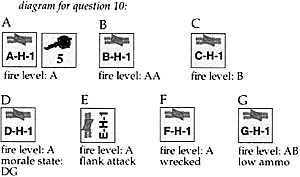 diagram for question 10:
diagram for question 10:
If you said A, B, F, or G, you are a blood-thirsty butcher who favors human wave attacks, or maybe just the union commander at Antietam. Each of these hexes is pretty strong and will be hard to take. Even F-H-1, who is wrecked, will dish out a lot of punishment, and if you don't pass you attacker's close combat morale check, his wrecked status isn't going to matter. With that -6 modifier to the morale check, you are likely to retreat with a rotten morale state, ripe for blasting in the forthcoming Defensive Fire Phase. I could see many gamers taking on F-H-1 in close combat, but I wouldn't do it if I didn't have to. Even though G-H-1 is low ammo, he's still going to be pretty tough in close combat. Leave him alone.
On the other hand, choices C, D, and E are all reasonable targets. C-H-1 can't hurt you very badly, and his is likely to be blasted down to a C fire level, wrecked brigade during close combat. If you manage to stick around after your morale check, you are going to get the hex and then watch him take another harsh morale check after he retreats. Hitting D-H-1 and E-H-1, the DG and flank targets, should be obvious. They won't shoot back well and will be really hurt if they have to take their morale checks.
![]() Most CWB players have far more stories about dumb close combats they wish they hadn't done than they do of one that broke the opposing line. Be careful and think hard before doing it.
This is your division:
Most CWB players have far more stories about dumb close combats they wish they hadn't done than they do of one that broke the opposing line. Be careful and think hard before doing it.
This is your division:
11. How do you get the artillery into the attack?
- A) Run it up to two hexes with the infantry.
B) Infantry to one hex to screen the guns at two hexes.
C) Guns to three hexes, firing through a gap in the infantry line.
Depending on your style of play, B or C would be correct. Both work well, though I have had more luck with method C. Rule 26.6, which states that all qualified enemy units can fire at artillery which unlimbers at or within two hexes, makes answer A is a dumb choice and is the driving force for choosing either B or C. [Ed. note: Even I got this one right away. Choice A gets your artillery clobbered while limbered (+2 on the Fire Combat Table), then your infantry has to make what would have been an avoidable straggler check. A variation on choice C is to unlimber at 3 hexes, keep the infantry back, and start the assault with a gun duel]
Method B: Getting the artillery to two hexes. First:
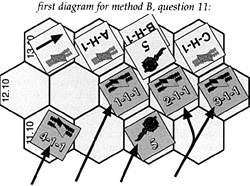 first diagram for method B, question 11:
first diagram for method B, question 11:
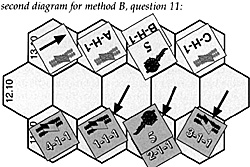 Then: second diagram for method B, question 11:
Then: second diagram for method B, question 11:
And voila! The guns are on line, stacked with the infantry to give each other the benefits of infantry/artillery stacking, the infantry has a continuous line, and all the infantry is in range. If 1-1-1 or 2-1-1 were forced to retreat by defensive fire (about 1/3 chance), the battery could fire on the turn it unlimbered.
Method C: Artillery at three hexes
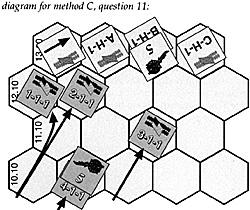 diagram for method C, question 11:
diagram for method C, question 11:
The battery deploys without getting fired on and can fire on the same turn it unlimbers with no delay. Due to the 2-3 hex range bracket, the artillery here performs just as well as artillery pushed to two hexes, although it doesn't provide stiffening to the front line brigades.
12. Assuming that the two methods for deploying the guns are equally effective, how is the infantry deployment for method C, as illustrated, better than that for method B?
- A) The attackers are concentrating on the extended brigade A-H-1.
B) The attackers are avoiding the high firepower of B-H-1 and the 5-point battery in hex 13/12.
C) The reserve brigade is out of rifle range (but still being useful).
D) C-H-1 and B-H-1 are forced to fire at the two-hex range.
E) All of the above.
The answer here is E. I can hear those players who insist on completely linear battle lines and those who think it unmanly to fight beyond one-hex range protesting now. Let me go into a little more detail.
A: 2 brigades are engaging one brigade. A-H-1 will take twice as many casualties as 1-1-1 and 2-1-1, and the Rebel unit will wreck twice as fast. This leaves a nice hole in the line.
B: Hex 13.12 can put out 9 fire points at one-hex range, causing almost 50% more stragglers and casualties than its 5-point, range-two shot. This will save, on average, on casualty box per fire phase. Over 3-4 turns, that will allow 3-1-1 to stay on line an extra turn. By that time, A-H-1 will be blown away, and 3-1-1 and 4-1-1 will be fresher and ready to push on through the space vacated by A-H-1.
C: Keep a reserve brigade. More on that later.
D: Same rationale as B above. while the two-hex range shot also reduces the firepower of 3-1-1 to 2 points, it is paring 3-1-1. Besides, 3-1-1 can combine fire with the attacking battery in 10.11 for a decent attack on hex 13.12, once that battery has knocked the defending battery down to 4 gun points. (Remember to do a little counterbattery fire.) At that point, B-H-1 and 3-1-1, backed up by their artillery, will be trading volleys of 4 fire points each.
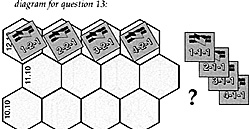 diagram for question 13:
diagram for question 13:
13. Your division is supporting the 2-1 division's attack. Where do you put your brigades?
- A) 11.11- through 11.14
B) 11.11, 11.13, 10.11, 10.13
B is the better answer. If you're deployed in a straight line as in answer A, a rout or DG in the front line will adversely affect your supporting units. Leave a lane for front-line units to retreat through if they have to, or that nasty 66 morale check will get you.
 14. On an attack on a four-hex frontage, how many of these go into the front line?
14. On an attack on a four-hex frontage, how many of these go into the front line?
- A) All four
B) Three up, one in reserve
C) Two up in extended line, two in reserve
Keep a local reserve! The answer should be B or C. I prefer to use B, bit I've seen C used as well and it seem to work. Discussion:
A: All four brigades on line. This will burn out all four brigades equally. The whole division will fail about the same time, making it ripe for a counterattack. There won't be a fresh brigade handy to exploit a fleeting opportunity. If a freak morale check routs one brigade off, one is available to fill the hole.
B: Three up, one back. On brigade is available to spell one of the front-line brigades if on of them suffers a bad morale result, excessive casualties, low ammo, or just needs to recover stragglers. Plus, it's available to attack enemy units which get disorganized or wrecked. Holding one brigade out can increase the division's staying power. Also, the one-hex gap in the four-hex frontage will allow the artillery to fire through.
C: Two up, two back. The two brigades in the front line really get punished. But then, they have two fresh brigades to spell them. Extending line with only one of them will spare the other brigade some casualties and allow the artillery to fire through. I think this is more brittle than three up and one back, but you can make it work just as well. [Ed. note: Without working through the numbers, here's my opinion: Extending line in general, and using option C here, are relatively good choices when your units have good morale and when you really need to have that infantry firepower available. This option is also better suited to the quick, overwhelming attack that to an extended firelight.]
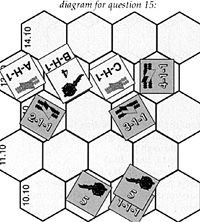 diagram for question 15:
diagram for question 15:
15. Should any of these brigades extend line?
-
A) 2-1-1 or 3-1-1 should extend to cover the gap in the front line.
B) 1-1-1 should extend line to cover the other gun.
C) 4-1-1 should extend to flank hex 13.12.
Answer: C is a great idea. Not only will the extender flank C-H-1, it will increase the firepower of 4-1-1 on a flanked, vulnerable target. After that shot, this brigade will probably not be in any kind of shape in its own turn to punish the extended 4-1-1.
I probably wouldn't do B, since the 1-1-1 brigade is back in reserve and I'd like to keep it fresh. The gun in 10.11 may need some stiffening, but I've found that most defenders focus fire on the attacking infantry when they get in a little trouble. Still, it's not a bad idea. A is a rotten idea, since that would block both batteries from firing.
Quiz complete. How did you do?
Whether you are a CWB grognard or a newcomer, hopefully you got something out of taking this quiz. Even if you didn't learn anything new, I hope it tweaked your brain into paying attention to some nuances next time you play a CWB game so that you have better results. This is just the beginning of better CWB unit handling. If you can think of a better way to do things, write in and explain why. In the meantime, I'll be working on a few larger-scale examples, perhaps for future issues of the magazine, and if I hear about some of your better ideas, they will somehow find their way into those examples.
[Ed. note: historically it has been in the CWB articles that Operations has most resembled a dialog, with different authors working from, or against, other authors' published ideas. I'll be glad to see letters and articles responding to David's.]
Back to Table of Contents -- Operations #26
Back to Operations List of Issues
Back to MagWeb Master List of Magazines
© Copyright 1997 by The Gamers.
This article appears in MagWeb (Magazine Web) on the Internet World Wide Web.
Other military history articles and gaming articles are available at http://www.magweb.com